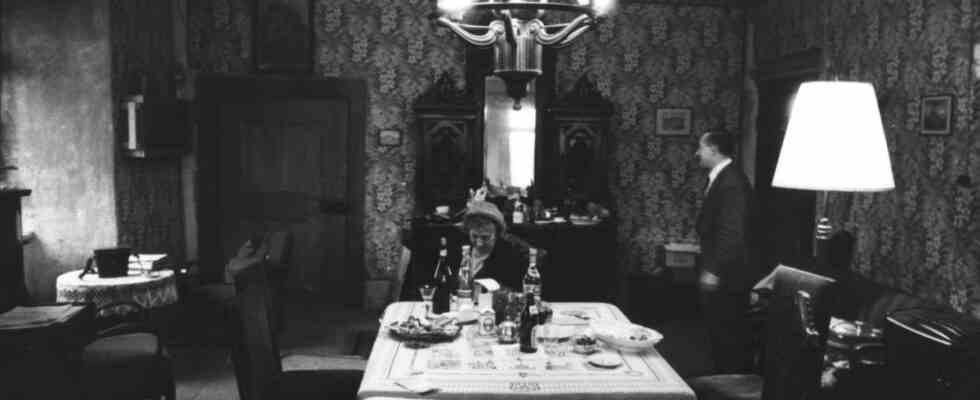On a gray day in November 1990, Kurt Benning set out from Munich on a journey that took him back to his childhood. His destination was the village of Waldau in the Upper Palatinate, where an aunt of his lived. In the 32 black-and-white photographs that he later published in a small illustrated book, Waldau appears sad and desolate. “German Village in Winter” is the title of this harshly existentialist little book, which was published by the ingenious Passau bookmaker Karl Stutz, who died young.
“In the early post-war period, up until the 1960s, the Middle Ages in the countryside had not yet been completely destroyed,” Benning wrote in the text accompanying the volume. He grew up very close to Waldau “still into the manners and customs of an old world”. A world that should not let go of the universal artist, who died in 2017. “His heart stayed in the Upper Palatinate all his life,” says Anjalie Chaubal, director of the municipal gallery in the Cordonhaus in Cham, where a retrospective of Benning’s complete works is currently being shown.
Benning traveled all over the world. After an apprenticeship as a watchmaker, he studied at the Academy of Fine Arts in Munich, then worked in London from 1969 to 1975. And yet he always returned to the Upper Palatinate. It was only after he had moved away that he discovered this region as a kind of lost homeland. The traces of human life and states of decay have had a lasting fascination for him and have accompanied him throughout his life, says Chaubal.
Recording from Benning’s series “Waldau – German Village in Winter – A Childhood Memory”.
(Photo: Kurt Benning Foundation, Munich)
In Waldau, Benning “(psycho-)analyzed a rural piece of Germany using photographic means,” author Gottfried Knapp wrote in the text accompanying the book. His goal was to “seek universal themes in the personal and in the mundane.” To this end, he observed processes and changes over a longer period of time. A highlight of the exhibition is undoubtedly the complete installation “Burgtreswitzmensch,” which has grown over more than 50 years.
As a young man, in 1969, Benning met the residents of a dilapidated castle. It was about a mother and her son, who indulged their passion for art and culture at Treswitz Castle in the Upper Palatinate Forest, networked worldwide.
Photo from the series “Burgtreswitzmensch”, 1969.
(Photo: Kurt Benning Foundation, Munich)
Benning accompanied the two of them for a long time and documented their life with the camera until their death. And even beyond that, because their traces and legacies were still there. The documented Benning clean and meticulous.
In the 1990s, Benning made video portraits of people from all social classes, professions and all ages in order to obtain as complex a picture of society as possible. The completed portraits include Walter Kempowski and Sigi Zimmerschied, among others.
This is how unique contemporary documents were created. Benning was ahead of his time in many ways. The art historian Günter Metken once wrote that Kurt Benning was one of the first to feel the loss that every demolition and every clear cut causes. He became a kind of early chronicler of the losses and secured traces of the ephemeral. In 1967, while still a student at the academy, he initiated a poster campaign entitled “Save Munich’s facades” and sparked interest in the city’s architectural heritage among many young people.
Kurt Benning – a portrait from 1980.
(Photo: Kurt Benning Foundation, Munich)
But what also distinguishes the chronicler Benning is the use of very different media. Ever since he was a student in the 1960s, he has been photographing, drawing, painting and filming, as well as creating three-dimensional object installations.
In the exhibition in Cham, not only the photo series can be admired, but also drawings, paintings, films and, last but not least, the literary contributions to his works.
Well aware of the fact that his life was limited, Kurt Benning founded the charitable Kurt Benning Foundation on his 71st birthday and shortly before his death. It has the task of preserving the abundance and quality of the artistic work from around 1970 until his death on March 24, 2017 for posterity and making it accessible. Next Sunday, February 26, Paul Bräg, who works on the artist’s estate as a research assistant at the foundation, will guide through the exhibition in Cham.
Kurt Benning – The discovery of the Upper Palatinate. City Gallery Cordonhaus Cham, until March 12 (Wed-Sun 2-5 p.m., Thu 2-7 p.m., Tel. 09971-8579 8420).

